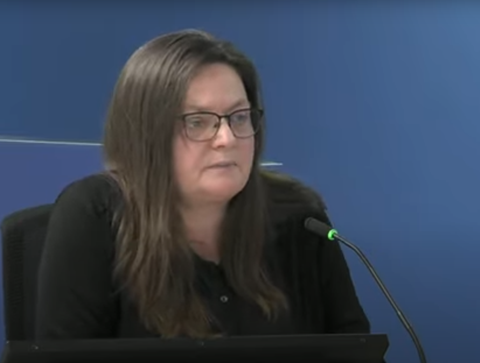Brian Martin had been responding to query on ŌĆ£poorly draftedŌĆØ clause in official guidance which appeared to permit use of combustible cladding in tall buildings
An ambiguous reply by a senior figure at the housing ministry to a question on whether ACM panels could be used in tall buildings was a typical response to fire safety queries, the Grenfell Inquiry was told.
║├╔½Ž╚╔·TV Research Establishment (BRE) scientist Sarah Colwell said she was ŌĆ£used to seeing the styleŌĆØ of Brian MartinŌĆÖs non-committal explanation of a confusing passage in official guidance dealing with cladding systems.
ThursdayŌĆÖs hearing was shown an email between Nick Jenkins, of cladding supplier Euroclad, to Martin seeking clarification on whether ACM cladding panels could be used on buildings taller than 18m. Martin was the policy lead for building regulations at the ministry.

║├╔½Ž╚╔·TV regulations on cladding systems stated at the time that the fire standard of ŌĆ£limited combustibilityŌĆØ only applied to ŌĆ£fillerŌĆØ materials, which was taken by many in the industry to mean materials used to fill gaps between insulation rather than the core of cladding panels.
Inquiry to the counsel Richard Millett QC said this month that the ŌĆ£poorly draftedŌĆØ clause had led to a ŌĆ£10-year legacy of misunderstanding by the UK construction industryŌĆØ.
Jenkins had initially sent his query to Colwell in January 2016, explaining that ACM panels ŌĆ£burn quite efficientlyŌĆØ and that he was aware of many tall residential buildings in the UK where the panels were being installed alongside combustible insulation materials.
Colwell then referred Jenkins to Martin, telling the inquiry that the housing department would be able to ŌĆ£take action more widelyŌĆØ.
Jenkins forwarded his email to Martin, adding: ŌĆØThis matter is currently the topic of much discussion in the construction industry and, if one thing is evident, it is that there is much confusion and misunderstanding.ŌĆØ
MartinŌĆÖs response to Jenkins, in February, said: ŌĆØI think the core of an ACM panel could reasonably be considered to be a ŌĆÖfillerŌĆÖ.
ŌĆ£So, unless the core material meets the ŌĆÖrulesŌĆÖ, then the [guidance] suggests a full-scale test.
ŌĆ£However, if the designer and building control body choose to do something else, then thatŌĆÖs up to them.ŌĆØ
Colwell was asked by counsel to the inquiry Kate Grange QC what her reaction was to Martin not being able to give a ŌĆ£definitive answerŌĆØ to the question. Colwell replied that the email was ŌĆ£very much the styleŌĆØ of MartinŌĆÖs responses.
Asked if this was typical of the style in which Martin would respond to these kinds of queries, Colwell added: ŌĆ£I believe so. HeŌĆ” I canŌĆÖt speak for him in the terms of how he writes, but that is typical of the type of response I had seen.ŌĆØ
Colwell, who admitted that she was ŌĆ£surprisedŌĆØ when reading JenkinsŌĆÖ original email alerting her to the use of ACM on tall buildings, was also asked why the BRE did not put out a statement to the construction industry alerting it to the dangers of using ACM.
She said it was ŌĆ£not a route that BRE had taken in those circumstancesŌĆØ.
Grange said: ŌĆ£Why donŌĆÖt we see presentations by the BRE, articles by the BRE?ŌĆ” why donŌĆÖt we see anything from the BRE about the dangers associated with ACM PE, particularly from this point onwards, once ŌĆō you know for sure at this point that it is being used on tall buildingsŌĆØ.
Colwell said: ŌĆ£We spoke where we were invited to speak.ŌĆØ
Earlier, the inquiry was shown an email exchange between David Metcalfe, director of the Centre for Window and Cladding Technology, an industry body which provides guidance on facades, and Stuart Taylor of facade engineer Wintech.
Taylor had been asking for advice on what cladding panels were compliant in a cladding system under official guidance.
Metcalfe replied that the ambiguous clause in the building regulations which referenced ŌĆ£fillerŌĆØ material ŌĆ£makes no reference to cladding panelsŌĆ” and the current view is that [this] does not apply to such materialsŌĆØ.
He suggested that the clause was ŌĆ£very poorly written and misleading, and needs clarifying ASAPŌĆØ, adding: ŌĆ£I am very sorry that I cannot give you a definitive answer ŌłÆ the more we look into the fire regulations, the messier it becomes.
ŌĆ£What is clear is that further guidance is needed.ŌĆØ
The inquiry continues.



























No comments yet